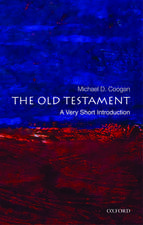The Bible Unearthed: Archaeology's New Vision of Ancient Israel and the Origin of Its Sacred Texts
Autor Israel Finkelstein, Neil Asher Silbermanen Limba Engleză Paperback – 15 sep 2002
Preț: 109.74 lei
Nou
20.100€ • 21.98$ • 17.38£
Carte disponibilă
Livrare economică 15-29 martie
Livrare express 01-07 martie pentru 48.64 lei
Specificații
ISBN-10: 0684869136
Pagini: 400
Ilustrații: 16 b&w photograohs, maps, line drawings
Dimensiuni: 140 x 214 x 25 mm
Greutate: 0.33 kg
Ediția:Reprint
Editura: Free Press
Colecția Free Press
Locul publicării:United States
Notă biografică
Israel Finkelstein is a professor of archaeology at Tel Aviv University. He is a leading figure in the archaeology of the Levant and the laureate of the 2005 Dan David Prize in the Past Dimension -- Archaeology. Finkelstein served for many years as the Director of the Institute of Archaeology at Tel Aviv University and is the co-Director of the Megiddo Expedition. He is the co-author, with Neil Silberman, of The Bible Unearthed (Free Press, 2001) and the author of many field reports and scholarly articles.
Neil Asher Silberman is director of historical interpretation for the Ename Center for Public Archaeology and Heritage Presentation in Belgium. He is a contributing editor to Archaeology magazine and the author of The Hidden Scrolls: Christianity, Judaism, and the War for the Dead Sea Scrolls; The Message and the Kingdom; and Digging for God and Country, among other books.
Cuprins
Contents
Prologue: In the Days of King Josiah
Introduction: Archaeology and the Bible
PART ONE
The Bible as History?
- Searching for the Patriarchs
- Did the Exodus Happen?
- The Conquest of Canaan
- Who Were the Israelites?
- Memories of a Golden Age?
PART TWO
The Rise and Fall of Ancient Israel
- One State, One Nation, One People? (C. 930-720 BCE)
- Israel's Forgotten First Kingdom (884-842 BCE)
- In the Shadow of Empire (842-720 BCE)
PART THREE
Judah and the Making of Biblical History
- The Transformation of Judah (C. 930-705 BCE)
- Between War and Survival (705-639 BCE)
- A Great Reformation (639-586 BCE)
- Exile and Return (586-C. 440 BCE)
Epilogue: The Future of Biblical Israel
Appendix A: Theories of the Historicity
of the Patriarchal Age
Appendix B: Searching for Sinai
Appendix C: Alternative Theories of the Israelite Conquest
Appendix D: Why the Traditional Archaeology of the
Davidic and Solomonic Period Is Wrong
Appendix E: Identifying the Era of Manasseh
in the Archaeological Record
Appendix F: How Vast Was the Kingdom of Josiah?
Appendix G: The Boundaries of the Province of Yehud
Bibliography
Index
Recenzii
John Shelby Spong author of Here I Stand: My Struggle for a Christianity of Integrity, Love, and Equality A bold and provocative book, well researched, well written, and powerfully argued. It challenges many of the assumptions developed by the literal religious minds of the ages, opening traditional possibilities to new conclusions.
Descriere
In the past three decades, archaeologists have made great strides in recovering the lost world of the Old Testament. Dozens of digs in Egypt, Israel, Jordan and Lebanon have changed experts' understanding of ancient Israel and its neighbours- as well as their vision of the Bible's greatest tales. Yet until now, the public has remained almost entirely unaware of these discoveries which help separate legend from historical truth. Here, at last, two of archaeology's leading scholars shed new light on how the Bible came into existence. They assert, for example, that Abraham, Isaac and Jacob never existed, that David and Solomon were not great kings but obscure chieftains and that the Exodus never happened. They offer instead a new historical truth: the Bible was created by the people of the small, southern nation of Judah in a heroic last-ditch attempt to keep their faith alive after the demise of the larger, wealthier nation of Israel to the north. It is in this truth, not in the myths of the past, that the real value of the Bible is evident.






















